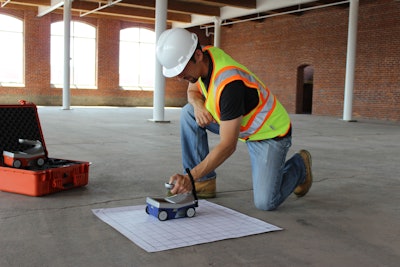Past the Surface: Leveraging Advanced Concrete Scanning Techniques for Unmatched Precision and Insight
In the world of building and construction and framework maintenance, the quest for accuracy and thoroughness is unending. Advanced concrete scanning strategies have actually arised as crucial devices in this search, providing a glimpse below the surface area to reveal a world of crucial insights. By harnessing cutting-edge modern technologies, specialists can reveal abnormalities, assess the condition of concrete structures, and make informed decisions that form the training course of jobs. The implications of these strategies prolong far past mere surface-level evaluations, assuring a depth of precision and understanding that is unparalleled.
Importance of Advanced Concrete Scanning
The value of using advanced concrete scanning strategies depends on the unparalleled accuracy they provide for spotting sub-surface abnormalities and guaranteeing architectural integrity. By utilizing cutting-edge modern technologies such as ground-penetrating radar (GPR), electromagnetic induction, and progressed sonar imaging, construction experts can delve underneath the surface of concrete frameworks with a degree of precision that much surpasses conventional inspection approaches. Concrete Scanning. These techniques make it possible for the recognition of surprise threats like rebar deterioration, gaps, channels, or post-tension cords that might compromise the stability and safety and security of a framework gradually
Additionally, progressed concrete scanning offers vital understandings into the overall condition of a concrete component without the demand for intrusive steps, reducing the danger of triggering damages throughout the analysis procedure. The capacity to identify the exact place and deepness of prospective concerns enables targeted repair work and upkeep, inevitably prolonging the lifespan of the structure and enhancing its performance. Essentially, the importance of innovative concrete scanning can not be overemphasized in the realm of building and construction and facilities maintenance, where precision and reliability are paramount.
Kinds of Cutting-Edge Technologies

Anomalies and Defect Detection

Along with GPR, concrete scanning techniques like thermography and impact-echo screening are also efficient in spotting anomalies and defects. Thermography makes use of infrared technology to recognize variants in surface area temperature level, showing prospective areas of concern such as delamination or moisture access. On the various other hand, impact-echo testing involves analyzing acoustic feedbacks to find spaces, splits, and various other defects within the concrete. By leveraging these advanced strategies, specialists can proactively deal with architectural problems, guaranteeing the longevity and security of concrete structures.
Assessing Concrete Condition
How can engineers accurately review the problem of concrete structures to ensure their longevity and safety and security? Examining the concrete condition is a critical aspect of preserving facilities integrity. Numerous sophisticated concrete scanning methods are used for this purpose. Ground-penetrating radar (GPR) is typically made use of to analyze the internal framework of concrete, spotting gaps, splits, and various other anomalies that may compromise its stamina. Furthermore, impact-echo screening can supply insights right into the density and honesty of concrete components. Ultrasonic pulse rate screening is one more valuable technique for evaluating concrete high quality by measuring the speed of acoustic waves via the material.
Incorporating non-destructive screening methods with visual assessments permits for a thorough evaluation of concrete condition, enabling designers to identify article possible concerns early on and carry out prompt maintenance or repairs. By leveraging these advanced techniques, designers can guarantee the long-term longevity and safety and security of concrete frameworks.
Enhancing Decision-Making Processes
In the world of framework administration, enhancing decision-making procedures is important for guaranteeing the reliable maintenance and longevity of concrete frameworks. Improved decision-making procedures in concrete administration involve making use of advanced scanning strategies to collect comprehensive information on the condition of structures. By leveraging modern technologies such as ground-penetrating radar and 3D imaging, stakeholders can make educated choices relating to repair work, reinforcement, or substitute approaches.
These progressed scanning techniques give vital insights into the inner composition of concrete, determining possible problems such as gaps, fractures, or corrosion that might not be visible on the surface. This degree of comprehensive details enables positive maintenance preparation, minimizing the danger of architectural failings Click Here and raising the overall life expectancy of concrete frameworks.
Furthermore, by including digital documents and evaluation devices into the decision-making procedure, stakeholders can track the evolution of concrete conditions gradually, allowing predictive upkeep strategies and maximizing resource allocation. Ultimately, the integration of innovative concrete scanning strategies boosts decision-making procedures by supplying unequaled precision, insight, and efficiency in infrastructure monitoring.
Verdict
Finally, progressed concrete scanning methods use unmatched precision and understanding in finding anomalies, problems, and assessing the problem of concrete frameworks. By leveraging sophisticated modern technologies, decision-making procedures can be improved, causing more educated and effective remedies for preserving and fixing concrete framework. These methods play a vital duty in making sure the safety and security and longevity of concrete structures, making them an indispensable device in the field of construction and design.
Additionally, advanced concrete scanning gives very useful insights into the total condition of a concrete element without the demand for invasive actions, lessening the threat of triggering damage throughout the analysis process - Concrete Scanning. An additional ingenious technology is 3D X-ray scanning, which gives in-depth images of the interior framework of concrete, using valuable info without the need for devastating testing. Additionally, Concrete Cover Meters are utilized to determine the density of concrete cover over reinforcement bars accurately. Boosted decision-making processes in concrete administration entail making use of advanced scanning methods to collect detailed information on the problem of structures.In final thought, progressed concrete scanning techniques supply unmatched accuracy and understanding in finding abnormalities, flaws, and assessing the condition of concrete frameworks
Comments on “Comprehensive Guide to Concrete Scanning Technologies”